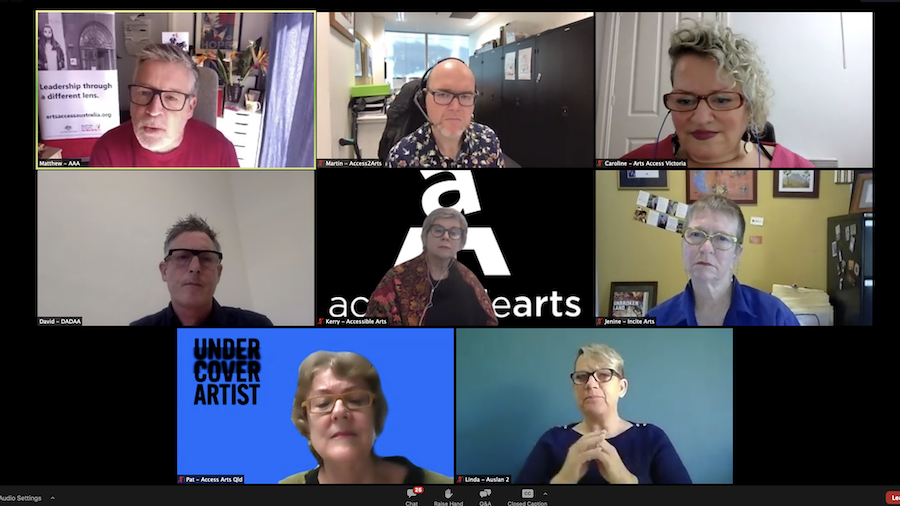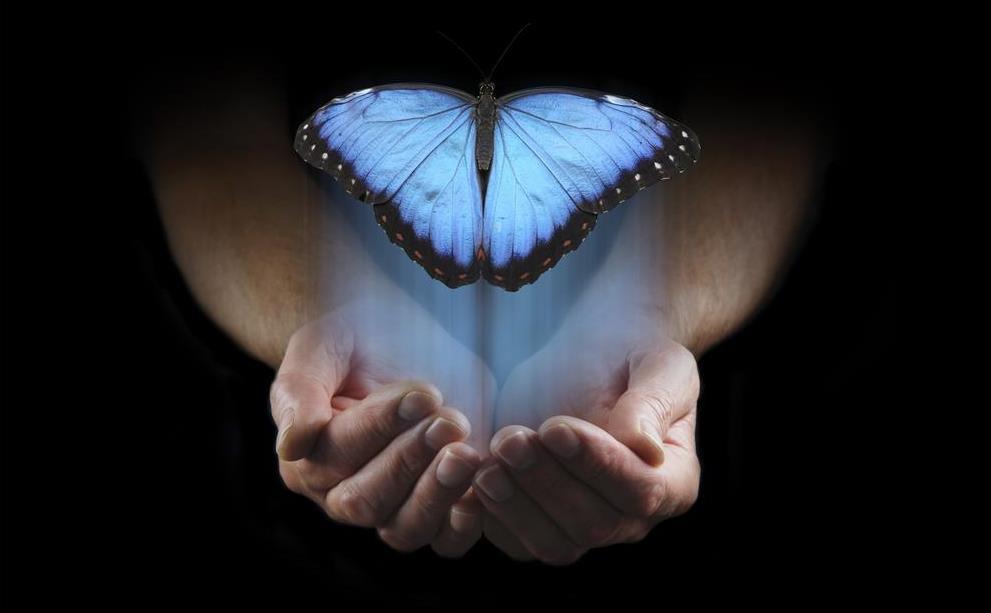This year’s Meeting Place Forum (15-16 September) started with a panel that brought together the CEOs and Directors of State peak organisations for disability arts and access. While we expect such voices to be loud and present, they presented a united messages as our world shapes its new future.
Newly-appointed Arts Access Australia CEO, Matthew Hall said that while COVID has allowed us to interrogate reasons for, and ways of, creating space in different environments, ‘looking at issues of leadership, and how we, as a group collective or as individual organisations, effect change and transforms the status quo’, is critical in the sector’s future road map.
CREATING OR FACILITATING?
The theme of 2020 Meeting Place was Creating Space in its most abstract and most practical definitions. Hall lead the discussion by asking each organisation whether they considered themselves creators or facilitators?
‘Do we create that space, or is it our role to ensure the conditions are optimal so that it happens?’ asked Hall.
Caroline Bowditch, Arts Access Victoria’s CEO, believes that it is a three-prong approach, each being quite distinctive: to make space; to hold space and to take space.
She explained: ‘You are talking about creating space [across this Forum]; we are talking about making space. How do you make space for disabled artists to show what their ambitions are? How do we keep those doors open and make those introductions to where they want to get to?
‘How do we encourage the sector to hold space for d/Deaf and disabled artists? And, how do we encourage d/Deaf and disabled artists to take space – to step into that space and have ownership over that space, and really lead that space.’
Brisbane-based Access Arts CEO, Pat Swell continued: ‘I see my role to create the conditions for my sector to flourish.’ She added: ‘My role is to see what people want and need, and to see the opportunities, and to then make it happen.’
Swell used the example, when starting at Access Arts [in 2012], she noticed there was a strong visual art program but nothing for performing artists. ‘So we asked them what they wanted and out of that came Undercover Festival.’
Accessible Arts CEO (NSW), Kerry Comerford said that while there is, ‘a lot of talk and desire to make space, it is really about ensuring we hear the voices of the artists, and to ensure that space is taken, and grows.’
Comerford said that the sector gets caught in creating space for small projects and seeing them as wins, but the greatest challenge is to create long term space for the sector.

Panel of Arts Disability leaders for Meeting Place 2020. Screenshot Zoom Webinar.
What does best practice ally-ship look like?
Adelaide-based Access2Arts Business Director, Martin Sawtell said that, more than anything, allys must recognise that they are supporting disabled people and that they are not speaking for them, or on their behalf.
‘They are using their existing influence to make a space for disabled, d/Deaf and disability voices to be heard, and to advocated and challenge when they see that voices of disabled people are not being heard,’ said Sawtell.
‘That is, a non-disabled ally can just make sure that disabled people are present and to be heard authentically – not speaking for these people – but even to just [constantly] ask why they are not in the room; that we need to hear from them.’
‘An ally needs to really recognise that it’s to support disabled people to have a voice, not to speak for them.’
Access2Arts Business Director, Martin Sawtell
Bowditch added: ‘At AAV, we have been trying to think about the word ally as a verb, not as a noun – it is being active not just a thing [you are labelled] – you are a change agent.’
When it comes to ally-ship she said the place to start is to ask the question: What have you done for d/Deaf and disabled people lately?
‘And ask that question regularly! And definitely at all meetings you are in,’ she added. Bowditch said it is critical that other voices are brought into the conversation – to consult, to engage, to inspire – in order not to speak on one’s behalf.
She made the point that in visual descriptions we are now using pronouns to introduce ourselves. ‘Say that in your introduction – if you identify being disabled acknowledge that, so we start to bring that in so it exists as an identity and a way of being.’
Read: Am I a good ally to disabled artists? (Bree Hadley, 2019)
Fremantle-based DADAA Executive Director, David Doyle said that it was a massive part of the role of any CEO or Director to supporting our allies to open up spaces for artist with disabilities, and invest in the long term.
‘Traditionally, a lot of arts and disability orgs in Australia were located on the edges of cities and towns, but over the last 5-years certainly WA has worked with our allies to create healthy spaces right in the centre of communities. And there has been huge investment by local and state government.’
Doyle said that Disability Action Plans have been key to celebrating access, and to help scaffold and resource these creative spaces within our cities which traditionally artists with disabilities did not have.
‘The politics of disability and bringing everyone along on that journey, it is a long and tough journey but it certainly it should be done,’ he added.
Continuing the COVID momentum of digital access and inclusion
When considering the topic of space across this Forum, digital ‘space’ in the wake of COVID-19 has enable greater inclusion, but has also highlighted inequalities of access.
Hall asked: ‘As important as the benefits that are being gained, how is it that we ensure – when things go back to normal in a true post-COVID way – those opportunities for greater access and inclusion digitally are maintained?’
Doyle said his organisation was required to keep operating through COVID as they were considered an essential service.
‘We had to move very quickly and one of the big learnings was that digital access and digital literacy is not even in WA. While in Fremantle and Perth it might be good, but if we look an hour out of city, there’s very low access to iPhone and iPads – a lot are not even on a computer – and don’t have digital literacy.’
Some artists living with disability are able to access IT through their NDIAS plan, and some are still strugging to get signed up while others may never be eligble.
‘That basic stuff is a responsibility we need to attend to,’ said Doyle.
Doyle added that the Ramsay Foundation got behind them to enable them to resource that population.
Sawtell continued: ‘There is this growing pool of digitally excluded people … a lot of people live in communities that don’t have unlimited broadband. After 30-mins of video conferencing they have exceeded their bandwidth for that month and then they are running a huge financial debt. It is not a universally inclusive space.’
He concluded: ‘While partially it is wonderful to be online, you also have to understand it is not the resolution to all of the access and issues of equality.’
Hall points out that this post-COVID return point will also face increasing financial challenges. ‘Before COVID hit we weren’t all awash with cash – the disability sector or arts and cultures sector generally [are not financially flush] – so it will be even tighter and private giving will be affected by impacted incomes.’
Hall suggests that there may be a shift to greater volunteerism, and that organisations need to be thinking about how to harness that to sustain the opportunities that great digital access during COVID has offered.
Diversity in disability & creating space in leadership
It was an audience question that prompted the panel to acknowledge the diversity inside disability, noting that those assembled were all white people creating space for disabled, who are also people of colour, Indigenous and with other intersectional identities.
Jenine Mackay, who is CEO of Incite Arts, located out of Alice Springs in the Northern Territory, said that 80% of the artists they work with are First Nations people.
‘My role as a non-Indigenous ally is to amplify their voices, and to realise the creative vision of those artists to better our best practice,’ added that their primary role is to be community engaged.
From DADAA, Robert Doyle continued: ‘We have to be champions of diversity, and not replace ourselves with like, or hire as like. You have to be very mindful or your white male privilege. What I can do is have a very proactive strategy around diversity.
‘We have 120 staff and incredible diversity statistics in our team, both in terms of staff with lived experiences of disability and non-English speaking backgrounds,’ he added.
Hall pointed to the recent discussion paper by the Australia Council for the Arts, Re-Imagine, and follow its lead in asking, How do we create new leadership; how do we share and shift the power?
Describing it as a ‘huge scary question’, Sawtell said: ‘I want to use the power I have, if I am in the room, to be mindful of who is not in the room, and ask the question why?’
‘I am very aware I am not the only person [with a disability] and that there are so many other voices that need to be heard. We have to call it out,’ he added.
Read: Leading for change – who’s leading disability arts?
Bowditch took it as a cue for positive restructure. ‘Part of our role is growing the next leaders.’
‘It is about clear succession plans and it is working closely with community to bring those people in and grow those leadership skills, so you can step aside,’ she continued.
Arts Access Australia will present The National Arts and Disability Award (Emerging Artist and Established Artist) for its second edition, announced on the National Arts and Disability Awards (Emerging Artist and Established Artist).
The AAA award will announce the National Leadership Award, in conjunction with the the Australia Council value at $10,000.
Meeting Place is an annual forum presented by Arts Access Australia. The first edition was held in 2012.
ArtsHub was a proud media partner for the event.





